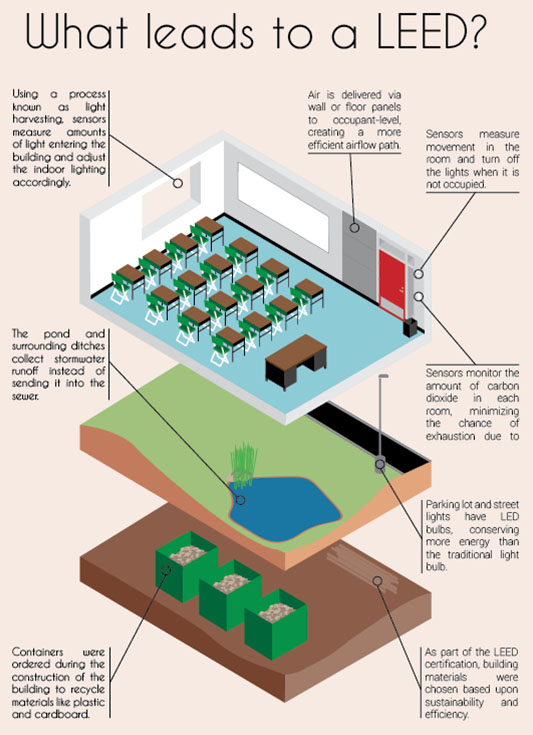Administrators explain reasoning for school’s LEED certification
Daylight harvesting. CO2 sensors. Occupant-level air diffusers. Stormwater retention ditches. These instruments may seem far-fetched, but all can be found in the school as part of the Leadership on Energy and Environmental Design (LEED) program, which the school is certified by.
According to usgbc.org/leed, the program changes the way people think about how buildings and communities are planned, constructed, maintained and operated. This program addresses sustainability and resource efficiency in building design, construction and maintenance.
To build for LEED awards, the organization — in this case, the school district — must accumulate a certain number of points. These can be gained by doing anything from using approved building materials to implementing certain processes in the building.
“The whole idea is ‘can you design a building with a smaller carbon footprint?’” principal Scott Roberts said.
Such instruments implemented in the school include sensors which monitor the levels of carbon dioxide in the room, preventing excess fatigue. Panels on the wall in classrooms and under the floor in office spaces also help regulate air quality and ventilate the building more efficiently, as compared to older methods of introducing air from the ceiling.
“As we breathe in and out we are creating carbon dioxide,” said Scott Crain, district director of design and construction. “Those contaminants are stratifying in the upper levels of the space and when we add air, what we are doing is we are remixing all that in the space. What we experience in this building is air that is delivered at the level of the occupants. It creates higher indoor air quality for students and a better environment.”
Another feature is the school’s daylight harvesting system. Observing the windows throughout the building, sensors can regulate the amount of light coming inside. On an overcast day, all banks of lights may need to be on, while on a sunny day, no extra light may be needed at all. Also, occupancy sensors can detect when there is movement in the room and can turn off the lights accordingly, monitoring when rooms are empty.
Additionally, the school grounds feature stormwater retention sites. The pond and surrounding ditches are made to trap and store runoff in an effort to minimize the amount of water flowing into the stormwater system.
“The biggest benefit is directly to the students,” Crain said. “I know it creates better learning environments. When you are in a space where you are not being distracted by being too hot, too cold … falling asleep because the CO2 levels are too high, there are studies that prove students learn better in those type of situations.”
Due to this focus on education, a balance must be found between energy-efficiency and creating the optimal education space. For example, windows — not known for their insulation benefits — are abundant in the building to achieve that better learning environment, Crain said. The LEED program has guided the district toward this.
However, certifying buildings takes time and money. The district has modified building processes, choosing to implement practices learned from the LEED program and not seeking the official certification. Certain district buildings — such as Southwest, CAPS and Timber Creek — have acted as “pilot schools” for the district to test out the program.
“You can design to those LEED principles without actually putting that plaque on the wall… We did that a few times then realized we can get the same building and provide the same experience for the occupants without spending those taxpayer dollars to highlight the fact,” Crain said. “Whether it is a major renovation, a small building addition, a brand new facility, we are going to incorporate those principles into our process, but we are not going to seek that recognition for that. We have proved we can do it.”
Although the district has begun implementing energy-efficient processes in the facilities, it still has a main focus on education.
“Generally we have those things which create exceptional learning environments,” Roberts said. “We are more about creating those exceptional learning environments than saving energy, per say. We want to do both when we can, but our ultimate goal isn’t to save every penny of energy. It is to provide a place for students to learn.”
